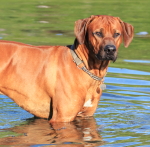That's very true Ally, stretching and yawning action is indicative of wet canker. Do you think this is enough of a test rather than swabbing back of throat etc? I had it in loft a few years ago, not all the doos but a few, treated with ronidazole. I check them now and again and haven't seen any reaction. From Colin Walker What is wet canker? Everyone who has kept pigeons for several years knows what wet canker is. The yellow material seen in the throat is regarded as the dry form of the disease. As pigeons mature, they develop a natural immunity to the canker organism and as a result their response to the canker organisms is modified. Young pigeons who have not yet developed a natural immunity, if they come under stress or are exposed to large numbers of the organisms, quickly develop a severe infection, with large numbers of the organisms present, and the characteristic yellow material becoming visible. Most young pigeons have a few trichs (canker organisms) in their throats. This is not a problem and in fact can be a benefit. This low-grade, ongoing exposure stimulates the development of a natural immunity in the young growing pigeon. As the pigeon becomes older and its natural immunity rises, it therefore becomes harder and harder for them to develop visible canker. But in pigeons of any age, there are always a few trich organisms present. The numbers tend to rise and fall, principally depending on what stress the birds are under and the level of exposure to the organism. In race baskets, canker organisms quickly spread through the drinker and the race itself provides no end of stress – time away from the loft, altered feeding patterns, exertion, exposure to predation, etc. Because of this, canker organisms fluctuate in the throat throughout the season. Usually nothing is visible to the fancier. In very high levels, the throat might appear a bit red or mucousy but this is very subjective. Often when testing birds with what appear to be good throats, high levels are found and vice versa. Trichomonads are primary parasites, taking nutrition that would otherwise be available to the birds and releasing toxins into their system. As trichomonad levels rise, race performance drops away. Fanciers who try to race teams with high trichomonad levels can expect to win fewer prizes and lose more birds. Birds with elevated trichomonad levels are said to have wet canker. How to monitor wet canker? By far, the best way to monitor this problem is to have some saliva from the back of the birds throat and top of the crop examined under a microscope. This is a simple test that takes a couple of minutes. Any vet with avian experience can do this for you and I met some very capable vets at Blackpool, including Lizzie Rigby and David Parsons. In Australia, most vets would not charge a consultation fee for this service. Certainly if you go in to a vet’s clinic with sick pigeons that are going to need an investigation that will take time, expect to pay a consultation fee, but in Australia many of our clients bring in a few birds every few weeks for the test (called a crop flush) and also ask to have the birds’ droppings examined (we will talk about this in a later article). In this situation, we just charge for the test, which in Australia is the equivalent of about 8 pounds. We do the test, give the fancier the result, offer some advice about the result, and expect to see them again in about 3 – 4 weeks.





